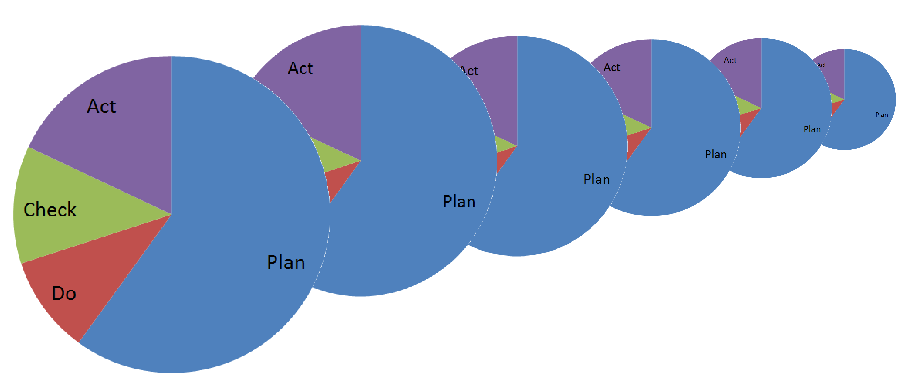6.5 Lean tools
Value Stream Mapping: visualization of work considering time, quality and value
- objective: discovering potential wastes for elimination
- lead time: elapsed time between a new task comes from the customer and the results arrive back to the customer (customer perspective)
- value added time: effective work time needed to accomplish the task, value creation time
- most of the times value added time ratio is lower than 5-10% of lead time
- How to improve?
- drawing the current state of the value stream map
- drawing the future state of the value stream map (eliminate non-value-added work, waste)
- action plan, transformation
- Tool demo (LibreOffice)
- Value Stream Mapping has several symbols (e.g. see Wikipedia)
- a very simplified version of the essential steps can be performed in LibreOffice

Figure 6.3: Value Stream Mapping example
In the Value Stream Mapping example there are a lot of Non Value Added (NVA) steps while only some steps adds real value (VA – Value Added). NVA steps could be eliminated through iterative PDCA cycles. For example, the introduction of an automatic deploy system could eliminate the 14th and 15th steps, the introduction of an automatic notification system could eliminate the 16th step.
Kaizen (continuous improvement):
- System kaizen: improving the whole value stream flow, eliminate Mura and Muri (management)
- Process kaizen: eliminate waste (muda) at specific areas of value stream (teams, individuals)
- Daily kaizen: spontaneous improvement by immediately identifying, analysing, solving and evaluating problems occurred during the day
Gemba (real/actual place) walking
- walk around the organization to see the problems, waste, (Mura, Muri, Muda)
- walk to the customer’s place to see what really happens and how and to reach common understanding about the product/service
5S (Sort, Set in Order, Shine, Standardize, Sustain)
- Clean and organized work environment, workplace
- Standardized work
- Variation in work methods results in varied quality, time and costs that is not acceptable
- Sefining and documenting the most effective method to perform a task
- Established by individuals and teams from their shared knowledge and experience
- Disorganized workplace results in disorganized work, i.e. in waste
Root cause analysis
- Discovering and dealing the origins of problems instead of the symptoms
- Fishbone diagram, brainstorming
- Start with a skeleton diagram and extend it during the brainstorming session
- First, start with the cause families/groups
- 5Why: asking “why” until we reach the root cause of a problem
- Usually 5 why is enough to discover the root cause
- Validating the root causes by forming statement sentences backward
- Combination: first use Fishbone for brainstorming to identify symptoms and causes and then apply 5Why to identify real root causes
Zero defects
- Source inspection: perform root cause analysis and fix root causes
- 100 percent inspection: do it effectively with low cost
- Fix defects immediately
Kanban
- Card system to ensure just in time production
- Limits for work in progress
PDCA: Plan Do Check Act, iteratively doing the following steps:
- Plan: observe the current situation, discover problems and root causes, define goals and countermeasures, create plans. This is the most important step!
- Do: execute the plans, test the hypothesis
- Check: measure the effects, are we solve the problem, reach the goal?
- Act (Adjust): make adjustments and improvements to ourselves, processes based on the current experience.

Figure 6.4: Bad usage of PDCA: one cycle project, planning is not enough, acting benefits will appear only in the next project but meaningless because of different circumstances

Figure 6.5: Bad usage of PDCA: planning is not enough, acting is missing.

Figure 6.6: Lean PDCA (suggested to use): several cycles with reasonable amount of planning, checking and acting to boost up learning curve and common understanding through the way to achieve goals. Cycle time shortens because of rapid iterative learning.
A3 thinking: summarize and communicate problem solving with an A3 paper
- Essential elements, e.g. definition, scope, process, measures, results, etc.
- Strongly connected to PDCA
- Other use cases: proposals, reports, etc.
- Major objective: communicate and clarify current common and shared understanding of the underlying problem, project, any kind of thing
- it is important to differentiate an A3 paper from A3 thinking considering this objective
Autonomation, jidoka
- Partial, intelligent automation
- Much less expensive than full automation
- If something goes wrong the process is stopped and the problem is analysed and resolved and prevented to appear again (e.g. through root cause analysis)